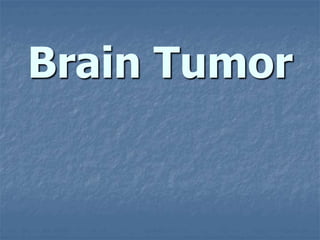
brain_tumor.ppt
- 1. Brain Tumor
- 2. Brain tumor Outlines Introduction Definition Classification of brain tumors Risk factors for brain tumors Signs and symptoms of brain tumor Diagnosis of brain tumor Treatment of brain tumor Nursing management
- 4. Definition of brain tumor A brain tumor is a localized intracranial lesion which occupies space with the skull and tends to cause a rise in intracranial pressure.
- 6. Classification of brain tumors Brain tumors can be benign or malignant Benign brain tumors: Benign brain tumors do not contain cancer cells: usually, benign tumors can be removed. The border or edge of a benign brain tumor can be clearly seen. Cells from benign tumors do not invade tissues around them or spread to other parts of the body.
- 7. Classification of brain tumors (cont…) However, benign tumors can press on sensitive areas of the brain and cause serious health problems. Unlike benign tumors in most other parts of the body, benign brain tumors are sometimes life threatening. Very rarely, a benign brain tumor may become malignant.
- 8. Classification of brain tumors (cont…) Malignant brain tumors: Malignant brain tumors are generally more serious and often is life threatening. It may be primary (the tumor originate from the brain tissue) or secondary (metastasis from others tumor elsewhere in the body). They are likely to grow rapidly and invade the surrounding healthy brain tissue.
- 9. Classification of brain tumors (cont…) Very rarely, cancer cells may break away from a malignant brain tumor and spread to other parts of the brain, to the spinal cord, or even to other parts of the body.
- 10. Risk factors of the brain tumor Being male Race Age Family history Being exposed to radiation or certain chemicals at work
- 11. Symptoms related to increased intracranial pressure such as: Decrease in level of consciousness such as confusion and lethargy. Headache most common in the early morning and made worse by coughing or straining Signs and symptoms of brain tumor
- 12. Vomiting Papilledema ( edema of optic nerve)and visual disturbance Alteration in mental status. Signs and symptoms of brain tumor (cont…)
- 13. Signs and symptoms of brain tumor (cont…) Localized symptoms such as: Aphasia Personality changes as in case of frontal lobe tumor Sensory defects ( smell, hearing). Seizures. Motor abnormalities
- 14. Diagnosis of brain tumor Physical exam Neurological examination Brain CT scan MRI on brain Angiogram Biopsy
- 15. Treatment of brain tumor A variety of medical treatment modalities, including chemotherapy and radiotherapy, are used alone or in combination with surgical resection. Supportive care include: Steroids Anticonvulsant drugs